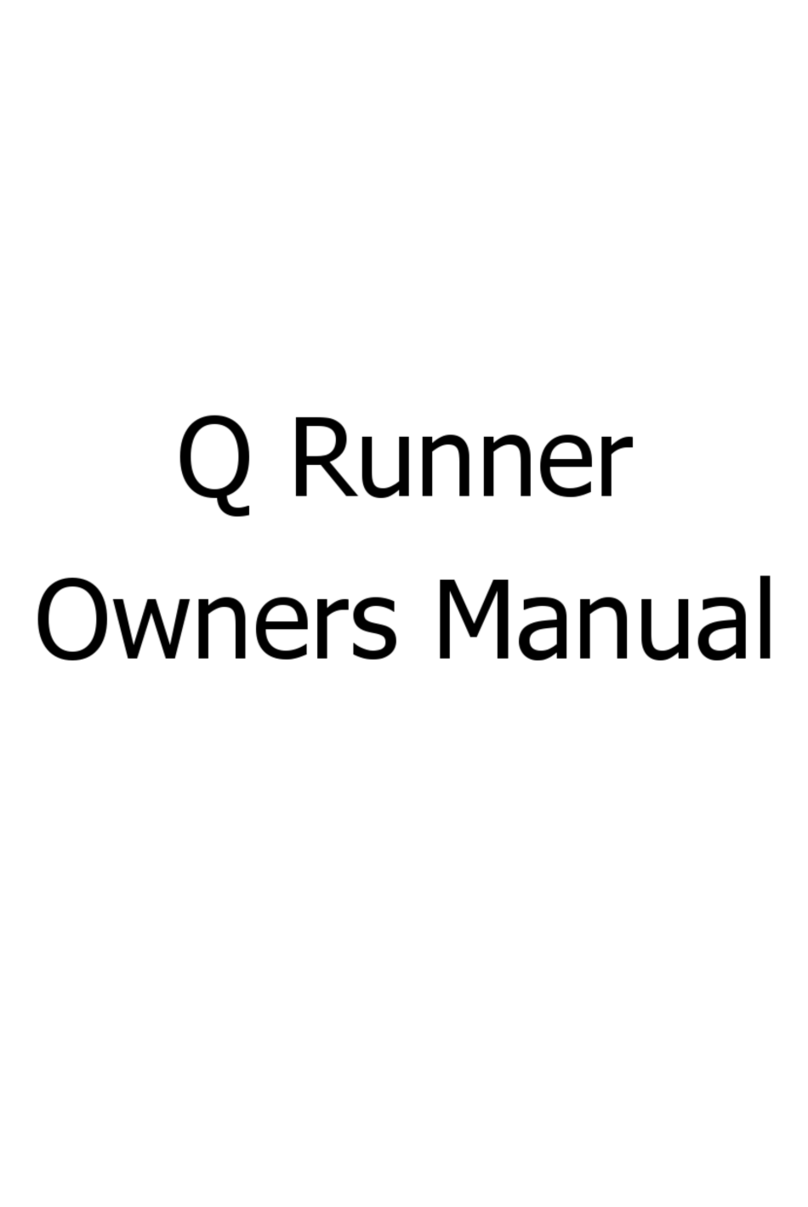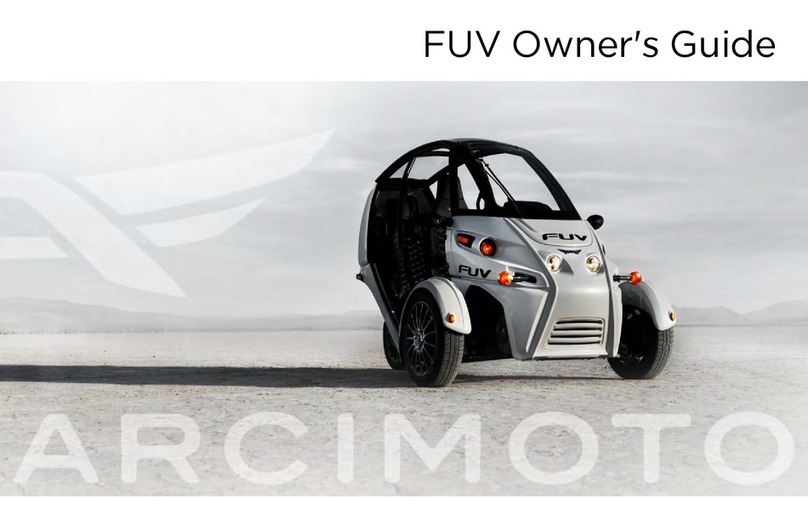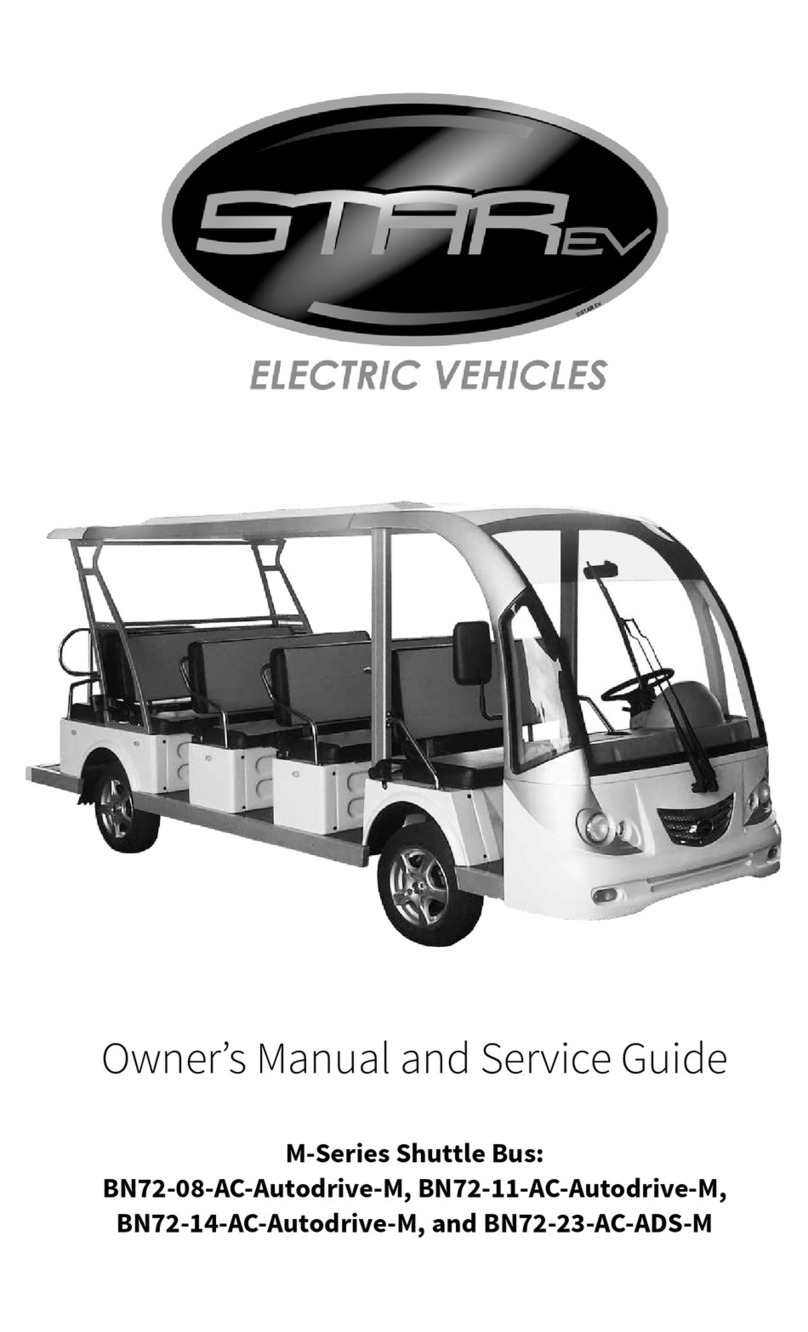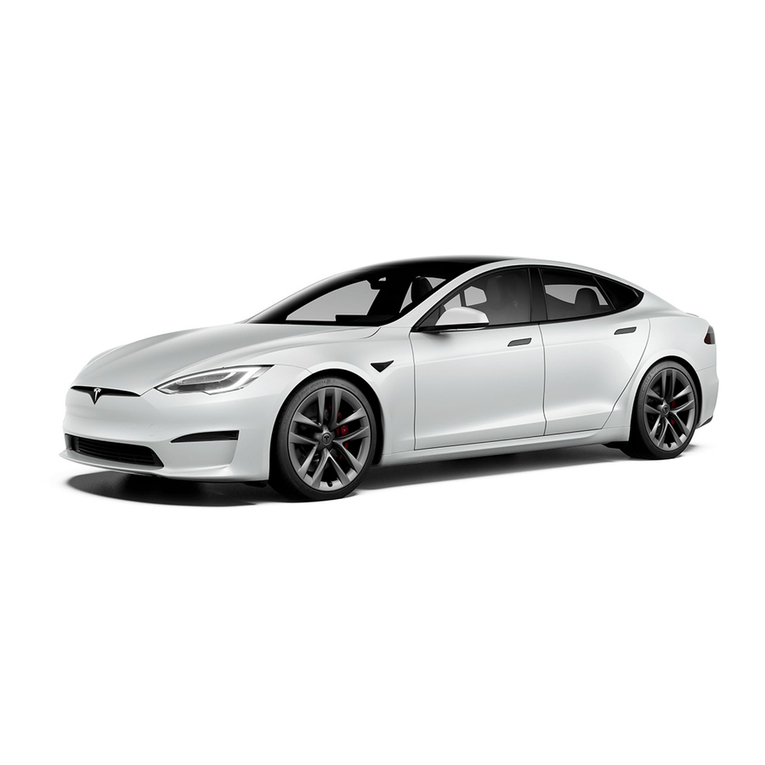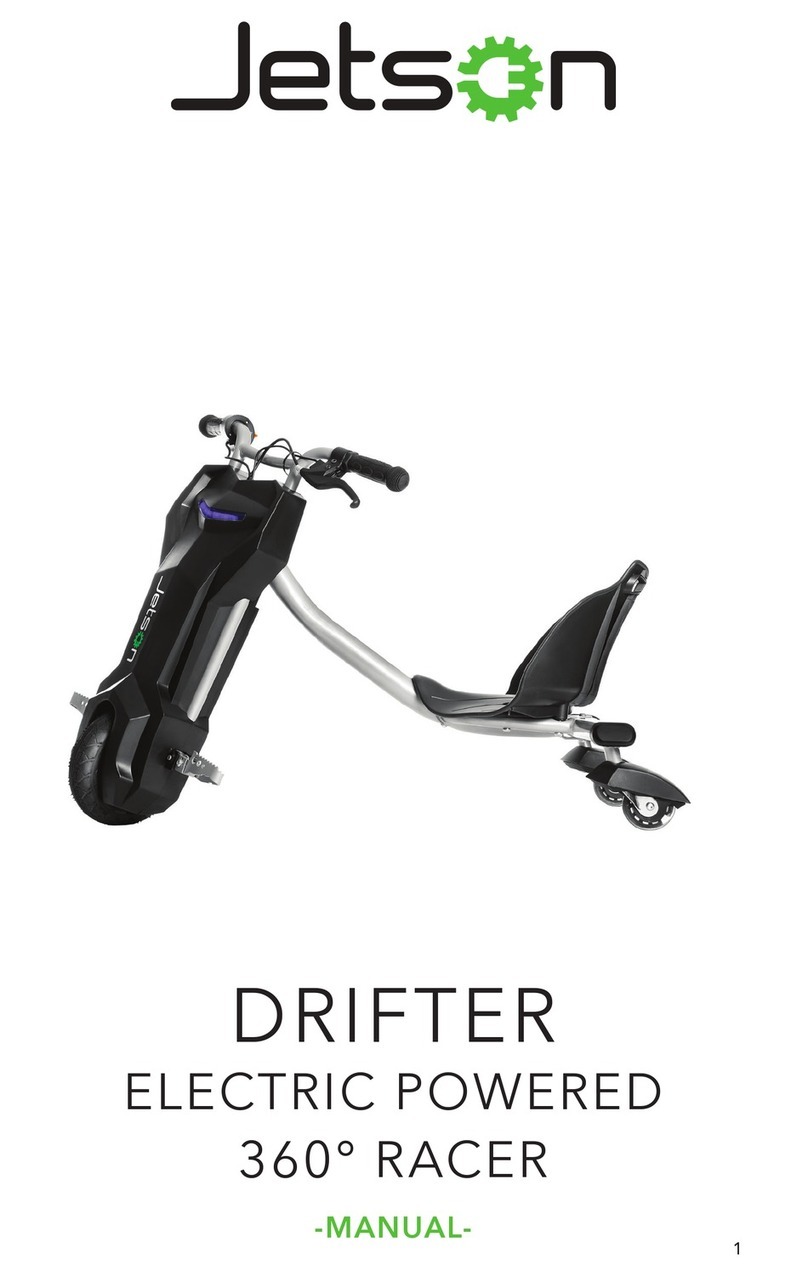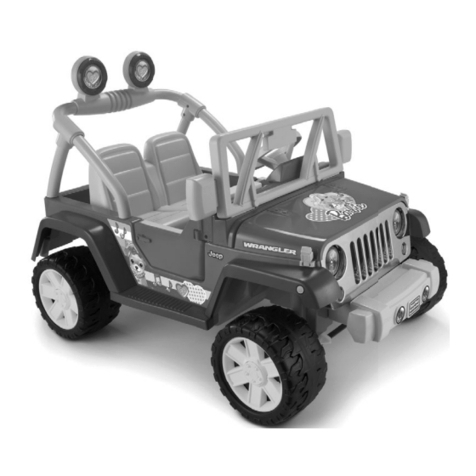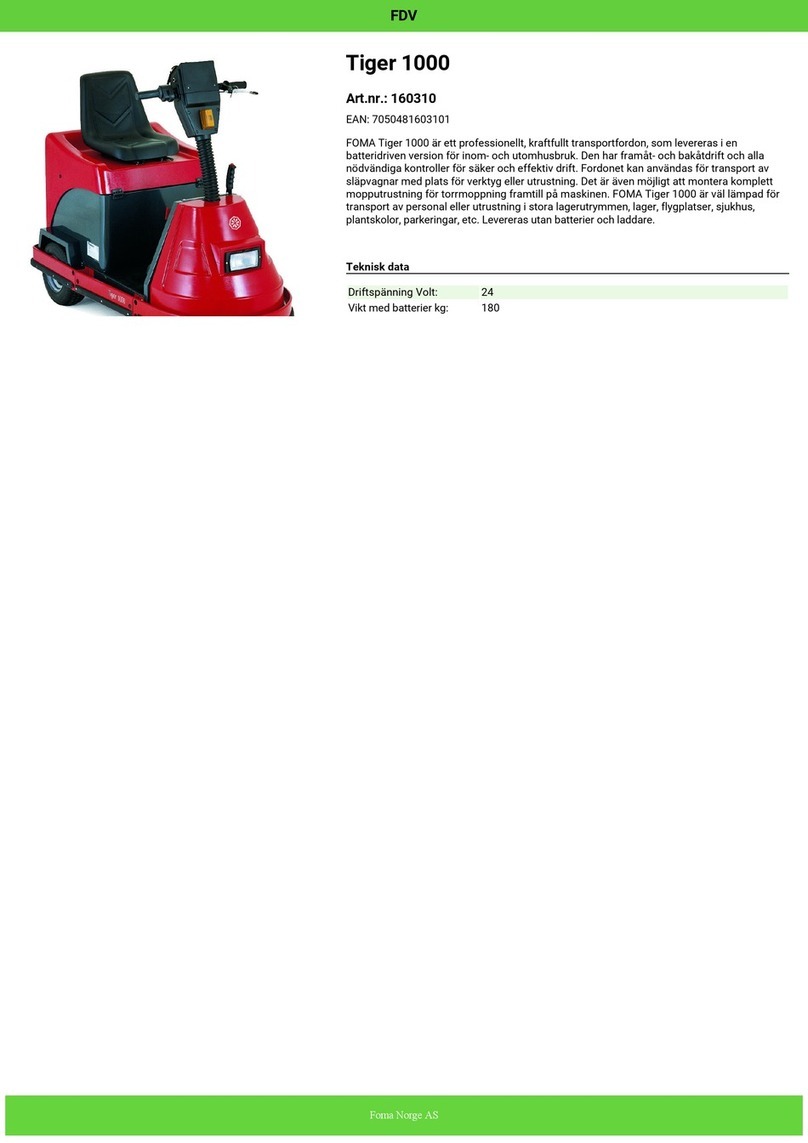Green Transporter Q Pod User manual

Q Pod
Owners Manual

Q-Pod
FOREWORD
Thank you for choosing our Q-Pod. Before driving, please read this manual to know
your vehicle well.
All data referred in this manual is up to the minute. As we are constantly updating
our vehicles, this manual may be renewed without immediate notice.
Note: optional equipment are also described in this manual. So there may be
some explanations not applicable to your vehicle.
ATTENTION
1. Inspection before driving:
- if all the lamps are working well;
- if windshield and rear-view mirrors are clean;
- if the position of rear-view mirrors are right;
- check the tire pressure and tire abrasion condition;
2. Braking
- avoid vehicle sliding when the power flameout;
- the abrasion of the brake lining depends on working condition, and its replacing
frequency depends on the driver’s habit and braking mode;
- make sure parking brake has been drawn back before leaving the vehicle;
3. If any warning tell-tale lighting during driving, please park the vehicle and check
at once;
4. Electric appliance accessories
- all electric appliance accessories should be connected on the required position in
right way
5. Please maintain the vehicle according to the maintenance plan;
6. All the operations should conform to this manual. We are not responsible for
any direct or indirect damages resulting from incorrect operations;
7. No unauthorized refit should be made, especially with such essential parts as
electric appliances, braking, steering, suspensions and tire systems. We are free of
any responsibilityfor any direct or indirect damage due to unauthorized refits.
8. We beg your pardon for the vehicle is constantly updating, descriptions and
figures in this manual may be not conform to the vehicle completely.

Section 1 Important note
■This signal note the best way to use your vehicle.
This signal with warning information, please read it carefully to avoid damaging
vehicle and for your and your family safety.
This signal is safety warning, means “can not”, “can not do that...” or “can not
make”.
Section 2 Vehicle instruction and dash board
Vehicle instruction Pic-1
1, Front windshield 2, Rearview Mirror 3, Wiper 4, Headlight 5, Left turning
light 6, Front wheel 7, Rear wheel 8, Door

Vehicle instruction Pic-2
1, Rear Window 2, Rear combination lamp 3, Rear glove box
Dash board Pic
1, Steering wheel 2, Left handle grip 3, Switch of headlight 4, Emergency lamp
5, Wiper switch 6, Door handle 7, Meter board 8, Gearshift switch 9,Right throttle
grip 10, Main switch 11, Brake pedal
Seat Pics
1, Rear seat
2, Front foldable seat
3, Brake handle
4, Seat adjustable handle

Section 3 Start and driving
1. Start note
■Make sure the charger has been unplugged;
■Key on motor, make sure every indicator and signal lamps are normal.
2. Start Procedure
(1) Turn on ignition switch, meter and indicator self-inspection;
(2) Shift to D or R position;
(3) Release parking handle, turn throttle grip gently.
Please don’t step on brake pedal heavily when start vehicle, please turn the
throttle grip gently to avoid damaging vehicle.
3. Stop vehicle
Please operate base on following step:
(1) Return throttle grip, stop the vehicle,then pull parking handle tight then turn
off vehicle;
(2) If stop vehicle on steep slope, please turn wheel to side walk and jam the
wheel by stone or block, if long time to leave the vehicle, please press emergency
switch and cut off main power.
(3)Don’t put key at “ON”position to avoid battery discharge. And remember pull
the key out, press emergency button.
(4) Don’t let the children stay in the car alone, and pull the key out and take the
keys away if you leave the vehicle.
4. Parking
(1) Pull up parking lever, don’t press the button.
(2) Before driving, make sure release parking lever completely. The concrete
procedure is: press button then pull up lever then release lever down.
If parking brake is not release completely, will make brake parts overheat,
effect the brake performance and wear out brake parts
Make sure pull parking lever up tight especially when park the vehicle on steep
slope.
(3) Parking note:
A. When park the vehicle on uphill, please shift to D gear, and turn the wheel
to sidewalk.
B. When park the vehicle downhill, please shift to D gear, and turn the wheel to

sidewalk, jam the wheel by stone or block.
C. Please take keys away if leave the vehicle, press emergency switch and
lock all doors, please try to park your vehicle on lighting place.
5. Brake system
(1) All of brake system parts are safety parts, so please maintain your vehicle
in after-sale service center.
(2) Brake system use hydraulic brake, the braking effect is more clear, effective.
Please stop your vehicle if brake system has the faults, and contact nearby
service center immediately.
(3) When driving in the rain, through large puddles, or after washing, the brake
discs can form a layer of water film, it will influence the normal braking
effect,
if
this happens, please driving slowly and check brake performance, till ensure
no problems then driving normally.
■Specially note: please replace the brake tube in repairing it to ensure the seal.
6. Shift using
Please stop vehicle before shifting, shift to D gear,
vehicle will run forward, shift to R gear, vehicle will run
backward. Please note , must stop vehicle, then can
shift to D or R gear as controller has the protect function
to ensure the service life of the motor.
7. Economy speed
Please drive the vehicle in constant speed to maximum the range. Driver can
adjust the speed base on vehicle condition and loading.
8. Preparation before driving
(1) Ensure safety, please inspect seat, brake, environment etc.
(2) Please make sure that has locked side doors, inspect rearview mirrors.
(3) Inspect all of indicators on meter are ok.
(4)Check the tire tread and the degree of wear. Pay attention to whether the
stone, nails, glass or other sharp objects on tread, whether a drum kit, scratch,
abrasion and other deficiencies. Once found, please replace the tire
immediately,and inspect the causes of abnormal wear. Check the tire nuts and
tighten degree, tire pressure is appropriate or not.
(5) Please check side turning lamp, turning signal and other indicators on
meter are ok or not.
(6) Step on the brake pedal many times, should can feel a little resistance. If

feel the brake pedal too light or travel too large, please go to after-sale service
center to inspect brake system or adjust the brake pedal.
(7) Please check the battery and cable, battery capacity will be low in cold
weather.
9. Running-in period suggestion
(1) In first 300 miles running-in period, please drive in slow speed to
extend vehicle life with good economy and power.
(2) Don’t start vehicle in fast speed, don’t speed-up rapidly, brake hard and
keep high speed long time.
(3) Don’t drive vehicle over 18 mph speed in running-in period, and also over
limit speed rules.
(4) Please don’t overload.
(5) Please don’t tow vehicle.
10. Driving tips
If you pay attention to following aspects especially, will protect you and the
other passengers.
(1) Drive carefully, pay attention to the traffic, road and weather conditions,
keep sufficient distance with front vehicle.
(2) When changing lanes, please observe rear view mirror and light turning
lamp in advance.
(3) Please observe other vehicle’s action and signal lamp, cyclist and walker.
(4) In vehicle emergency stop, please press emergency lamp.
(5) Driving on the water surface in rainy day, please travel slowly, the wading
depth cannot exceed the frame bottom, avoiding the fault caused by the motor
inlet.
(6) Accelerating vehicle slowly and steadily. Avoid unnecessary acceleration
and braking. As far as possible to keep constant speed.
(7) Must obey the traffic rules and do one good driver.
11. Please read the following instruction carefully .
(1) After the battery indicator begin to warn, please charge the battery in time;
(2) If control circuit system has the faults in driving, please press the emergency
switch, and tow the vehicle to service center then inspect and repair the vehicle.
(3) Please drive the vehicle constantly by economy speed, ensure the maximum
range, battery and motor service life.
(4) The vehicle in the cold case, battery activity will decline, the range will be
shorter than in summer, this is a normal phenomenon.
(5) Battery can not be left to stand too long time, need to recharge one month, if the
battery is stored without charging after using, Otherwise it will greatly influence

the service life of the battery, maybe will cause the battery scrap.
(6) When battery energy is exhausted, system will automatically cut power off. But
after that, the battery will rebound “virtual” voltage(voltage without power), so
need to charge before using, otherwise it will cause excessive battery discharge, it
will damage battery and can not be repaired.
(7) New Battery has charged in factory, but not fully, instrument display full power
is “virtual”, the user needs to charge in time according to the use of.
(8) Vehicle range: actual range will be affected by many factors( such as frequent
brake, start, a rugged road, steep slope, luff, under-inflated tires, overload,
environmental temperature etc.).
(9) Prohibit users to install electrical parts or refit other normal parts, otherwise the
user shall bear the resulting loss.
(10) Ensure your safety, please turn slowly.
(11) Prohibit climbing long time, if the vehicle in climbing process, the speed slows
down gradually, and eventually stop working, this is to protect the controller or the
motor, controller protection function, which belongs to the normal phenomenon.
Section 4 Meter and control device
1. Meter R When “R”indicator lights, means shift to reverse gear.
D When switch turn to D position, means shift to drive gear,
No indicator lights.
Indicators description: 1,left turning light 2, headlight 3, parking
brake
4, reverse gear 5, right turning light 6,battery voltage 7,speed 8, mileage 9,wiper
10 emergency lamp 11,voltage normal 12, under voltage 13, current volume
14, battery volume
Turning indicator: turn signal lamp installed on the instrument panel is the
green signal, it flashes means front and rear turning lamp work normally. If it
flashes too rapid or does not work, please inspect the bulb. If open the turning

switch and indicator does not work, please inspect the fuse, bulb and flash relay.
Press emergency switch, two indicators will flash at the same time.
High beam indicator: If this indicator lights means headlight lights.
Battery power warning indicator: Turn key to “ON”, when the battery voltage is
lower than a certain value in driving, the red battery power indicator lights, at this
time, battery need to charge timely. As it indicate the battery voltage, due to the
difference in driving state of vehicle( vehicle speed, acceleration). There are some
voltage bias.
■ Note: In order to ensure record the mileage effectively, recommend that users
reset subtotal odometer after a full charge(press the reset button for 4
seconds).often charging the battery less than 30 kilometers range, can effectively
prolong the service life of the battery.
Speed meter : show the speed(km/h), record the total mileage, and subtotal
mileage.
2. Ignition switch
Off: turn key to this position, power will be cut off,
can not drive the vehicle, but light system works
( include radio, cigar lighter, lamps, heater),key can not
be pulled out.
On: turn key to this position, power-train system is
switched on, can drive the vehicle, at the same time
lamps and all of electrical devices work, key can not be pulled out.
Lock: turn key to this position ,cut off whole vehicle power, lock steering wheel,
can pull out key or inset key.
If can rotate the key at this position, please rotate the steering wheel from left to
right slightly, then try to rotate the key again.
Please note can not rotate the key to “Lock”in driving, otherwise will cause the
steering wheel lock and accidents. Please note don’t put the key in vehicle or leave
child in vehicle alone.
3. Control Switch
a. Headlight and signal switch
OFF: close all of lights;
ON: all lights on
The vehicle does not work, do not let the headlight and other lights work too
long time.
This will cause excessive discharge of battery.
In rain or washing vehicle, there will fog in lamp lens, its same as glasses will
fog in wet weather, its normal, it will be defrosted after light lamps. But if the water
gathered in the internal, please inspect your vehicle in service center.

b.Turn signal
After turning on tuning signal switch( key at “ON”position), turning lamp will
flash, turning indicator will flash at the same time.
c. Horn button
Push the horn button, the horn will work loudly to warn other vehicles or
walker.
d.Wiper
Turn on the switch, the wiper will work in proper speed.
4. Emergency lamp switch
When some emergency cases, must stop or parking vehicle, please press the
switch to inform other drivers.
At this time, all turning lamps will work, please note need to rotate key to “ON”
position.
Parking in case of emergency or your car breaks down, please drive away road
and stop, unless forced by circumstances, otherwise too slow driving will lead to
traffic accident.
5. Rear-view mirror
Outside rear-view mirror can be adjusted manually, before the first driving, you
must adjust left and right rear-view mirrors sitting in the driver’s position to most
suitable position, it can be folded in special condition.
6. Charging interface
Located in the left side under the driver
seat of the vehicle, after open the protective
cover off, can charge the vehicle.
Please note: need to turn on main power
switch before charging.
Section 5 Emergency
1. Flat tire
Main switch
(1) If for some reasons, you need to park the vehicle on the road, please move to
the right-hand side of the road as far as possible, avoid parking in the driveway.
(2) Tighten parking brake, put the triangle warning to a proper position rear of the
vehicle ( no matter day or night)

(3) Tire blow-out
The tire was punctured and need to replace, firstly must comply with the safety
precautions: turn on the emergency lamp. Park the vehicle in the non traffic routes
and on the flat ground, make sure not to hurt you and damagevehicles. Tighten the
parking brake, shift reverse gear, turn off the power, don’t replace the tire on a
slope or a bumpy road, because its very dangerous.
Blocking the wheel
When the tire is flat, please find some blocks to jam the rear wheels and prevent
accidents.
2. Tools
Special wrench
3. Towing vehicle
(1) Traction premise
Please comply with the relevant local traction regulations when towing your
vehicle.
We recommend that please let the repairman tow your vehicle, incorrect
traction will lead to accidents.
(2) Towing attention
To use the right equipment, avoid damage to vehicle traction.
The transmissionmechanismof vehicle and steering mechanismmust be able to
work normally.
Please use reliable traction chain. Must release the parking brake in towing.
(3) Traction load
a.Tractor weight must be not less than towed vehicle, traction force must be less
than the tractor weight.
b.Can not add one vehicle more then tow the vehicle. Traction force will include
traction force from that additional vehicle, so total traction force will exceed
traction vehicle weight, holes or mud will produce additional traction resistance,
so will add traction load.
c.When the traction hook towing vehicle, to keep the traction angle less that 15
degrees. The traction angle is too large, may result in damage to the vehicle, and
even make the vehicle with 180° turning, pull the vehicle from the sand, snow or
mud, must make cable from the front straight out, not forming an angle with the
hook.
(4) Traction speed
Slow traction vehicle forward, avoid the impact force. High impact is very
dangerous, may cause the traction rope fracture, damage to vehicles. If you want
to pull the vehicle from a pit or mud, please ensure keep the distance with traction
rope or pole. Once the traction rope fracture, will have very big risk.

4. Towing by tractor
(1) Wrong traction
method
Can not use the method as shown in Pic(type A) tows vehicle by slings, using
slings will damage the front bumper and front structure
(2) Correct traction method
a.If the vehicle must be towed over 50 km, all wheels must be off the ground(type
B or C), as shown in Pic.
b.If the motor or differential gear is failed, all wheels must be off the gourd ( type
B or C), as shown in Pic.
c.The front wheel off the ground traction (type D), please release parking brake.
Note: Can not tow the sightseeing car from the backside when all the wheels on
the ground, because it may cause serious damage to the motor or the differential
gear.
When the vehicle failure, if there is the obvious resistance by pushing the
vehicle, please don’t push the vehicle by force, otherwise may cause damage to
the motor or other security issues. This kind of situation, must use type B or C
method to tow the vehicle, or ask professional service staff to cut off three-phase
electrical of motor before towing.
5. Inspect and replace fuse
Open the tail panel in the vehicle, pull off and check whether the fuse is good one
by one.
If the lamp or other electrical components do not work, should check the fuse, if
the fuse has been burned, it needs to replace. Turn ignition switch and ineffective
parts off, pull out fuse and check them.
If the fuse has burned, should be replaced by the new one. Only can install same
amperage fuse marked on fuse box cover, if cannot find the same amperage fuse,
please use lower amperage fuse, but must install the correct fuse as soon as
possible, please keep the replaced fuse for using again. It is best way to buy a set
spare fuse, put in the car for emergencyuse. If the new fuse is burned immediately,
maybe the electrical system has the faults. Please inspect the vehicle in service
center as soon as possible.
Never to use the fuse is higher than the rated amperage, or any other object to
replace the fuse, otherwise it will cause serious damage and may cause fire.

Section 6 Clean and maintenance
1. Inspection
(1) Brake liquid
Timely check the brake fluid level between the highest mark(MAX) and the lowest
mark( MIN). If you need to replenish liquid, only can use DOT4 synthetic brake
fluid.
Note: The brake fluid will absorb moisture. Therefore, if the vehicle is used in the
humidity higher area most of the time, brake fluid replacement frequency should
be faster than usual, please go to service center to inspect and replenish brake
fluid.
Brake fluid is harmful to the human body and is corrosive, if accidental contact,
please wash related body parts with cleaning water and neutral soap immediately,
and repeatedly wash. If put in mouth by accident, seek medical advice
immediately!
(2) Battery
Running 15~20 days shall timely check the battery electrolyte, and timely
replenishment.(Note: each battery electrolyte hole should be replenished one by
one) Maintenance free batteries do not need to check the electrolyte.
2. Lamp maintenance
A. Introduction
Operating light switch to check all the lamps are working. If the lamp is not lit,
usually due to fuse or bulb failure. First check the fuse, if fuse is not burned, then
check the bulb. If fuse and bulb is ok, please drive your vehicle to service center to
repair.
B. General rules
(1) Ensure lamp is turned off before replacing bulb, and inspect whether
corresponding contact point is oxidized or not.
(2) Please replace the broken bulb by same model and power new bulb.
(3) Please inspect the headlight after replacing their bulb.
(4) The internal surface of headlamps will cast a thin layer of water vapor in the
morning, it’s not a problem, is a normal phenomenon in low temperature and moist
air condition. That will quickly disappear after lighting lamp. The water appears
inside headlight, namely the water infiltrate inside, please drive your vehicle to
service center to repair.
(5) Do not use dirty gloves to hold the bulb. The oil on your hand will affect the
bulb replacement next time. If the glass surface dirty, must use alcohol, paint
thinner to clean. Completely dry and then re-install.
3. Cleaning
Often use vacuum cleaner or soft brush to clean the dust on decorative pieces,
plastic pieces and seat inside the car. To scrub the vinyl plastic and leather surface
with a clean soft cloth stained with weak alkaline soap water, then with a dry soft
cloth. Before using any fiber protector, you should read the manufacturer’s

instructions. Some fiber protector containing chemical agents, will make the seat
leave stains or fade. Never use gasoline, thinner or other solvents.
In the process of cleaning vehicle, the cab is strictly prohibited to flush water
directly, should avoid water flows into the boy of the charging socket. Prohibited
the use of high-pressure water rinse chassis parts, so as to avoid internal
electronic components and circuit accidents caused by wet.
■Wet controller, electric circuit or motor, will cause short circuit and damage
to
the electrical equipments.
4. Anti - corrosive measures
(1) The most common causes corroding sightseeing car
a.Wet dirt, dust or debris in the body plate, hole and other parts of the body.
b.The sand blow or coating resulting from minor accidents or other protective
layer damage.
(2) Environmentalfactors affecting corrosion rate
a.Moist
Accumulated sand, dirt and moisture in the lower body will accelerate corrosion.
The place accumulated snow and ice under the floor of the vehicle is not easy to
dry.
b.Relative humidity
Note: Corrosion would be accelerated in the following cases: high relative
humidity area, temperature above freezing point area, air pollution area, using road
salt area.
c.Air pollution
Industrial pollution, the salt in the seaside air and using too much road salt, will
accelerate corrosion process.
(3) Protection against corrosion of sightseeing car
Always scrub and wax the sightseeing car to keep it clean, often check the paint
if there are small damage and repair it as soon as possible, keeping the hole of
door bottom and rear shield is unobstructed to avoid water, check the lower body,
if there is sand, dirt and other salts, using water scrub clean as soon as possible,
do not wash the dust sand or other sundries inside passenger compartment,
should use the vacuum cleaner or brush.
Do not let water or other liquids contact electronic components inside the car.
5. Self-maintenance
Note: Some of the daily and regular maintenance is necessary for keeping
good mechanical properties of vehicle.
The user should arrange special maintenance and general maintenance.As the
owner you are the only way to ensure your sightseeing vehicle maintenance.
General maintenance including some items checked in daily driving, if you want
to keep your vehicle in continuous normal operation, this is the most basic

requirements. In the daily use of the vehicle, should be regularly carried
out
general maintenance, if you are aware of any abnormal sound, vibration or smell,
must check the reason or let service center inspect your vehicle quickly. In
addition, if you think that your vehicle needs repairing, please contact with service
center in time.
Here is a list of maintenance projects should always be carried out, unless there
are special provisions:
(1) Tire
Check the tire pressure with tire gauge regularly in service center, must be
adjusted to the specified pressure.
(2) Wheel nut
Check the tires, ensure wheel nut without loose. Check whether the loosening of
the wheel nut, tighten nut according to specified torque within 1000km ranges.
(3) Wheel alignment and balance
When driving on flat road, if the vehicle is titled to one side always, or your are
aware of the tire uneven or abnormal wear, it is necessary to align the wheel.
(4) Wiper brush
If brush works abnormally, please check whether there are cracks or wear.
(5) lamp
Confirm the front combination lamps, rear combination lamp and other lamps
work normally, be installed firmly, and check the lighting in regular maintenance,
cleaning vehicles etc.
(6) Warning lamp and buzzer
Confirm all of warning lamp and buzzer work normally.
(7) Steering wheel
Check the whether steering situation is changed, such as free travel is too large
or abnormal sound.
(8) Throttle grip
Confirm the grip steady work, and check the free travel is normal.
(9) Brake
Check vehicle if there is deviation in braking, brake lining is excessive wear or
not.
(10) Brake pedal
Check whether the pedal steady work normally, free travel is normal, and confirm
the pedal is stepped to the end, should reserve trip.
(11) Parking brake
Check whether parking brake travel is normal.
6. Regular maintenance
(1) Regular maintenance project must be carried out in the specified time interval,
it is requirements to ensure that your vehicle’s power system and mechanical
system in good performance. These works shall be done in service center. Note
that running under bad conditions, it needs extra or frequent maintenance.

Periodically, the maintenance is your
responsibility.
(2) The initial compulsive grinding
maintenance
In the early of 300/1000 miles compulsorymaintenance is one of the most
important maintenance, ensure your vehicle to achieve the best state is very
important.
(3) Where to do regular maintenance and
repair
Every 1500 miles for regular maintenance period. Reach the maintenance time or
your vehicle has the malfunction, please inspect and adjust your vehicle in service
station. Repair technicians are professional personnel be trained with regularity.
Through the technical manual, repair, and repair service center training courses to
get the latest repair information.
7. Battery maintenance
(1) The surface of the battery, pole and connecting bolt, connecting line should
keep clean and dry. If the electrolyte splashed on body please use cotton wipe
clean, then wash and dry, ensure no water enters into battery.
(2) Battery connection must be kept in good. Always check the battery
connection fastening and nut loosening, lest cause spark in driving to ablate
electrode.
(3) Don’t place any conductive materials on battery, can not connect the battery
positive and negative poles directly to avoid cause a short circuit and damage the
battery.
(4) After battery discharge(regardlessof vehicle ranges and driving time), must
be charged timely, charging tie should not exceed 24 hours delay.
(5) Because the electrolyte water electrolysis and evaporation will cause the
density increases and the level lower in using, so should always check.
In the charging of the battery terminal, please adjust electrolyte density to
1.28
0.0025(25℃) by 1.400 density dilute sulfuric acid specified for lead acid
battery, make the liquid height same as max. Level, continue to charge 0.5-1 hours
after adjustment, so that the internal consistency.
Note: In order to ensure longer life of your battery, please go to service center
to fill battery electrolyte.
(6) During charging, please put the vehicle at airy place, and open the battery
cover, after charging, tighten liquid injection cover, ensuring smooth gas. Don’t in
charge at smoking or stack flammable goods place.
(7) When close to lead-acid battery service life, battery capacity will declined
rapidly, must replace the new battery. The new battery must be the same with the
original vehicle battery manufacturers and same model. And the similar voltage
battery cell as a group(full charge, the difference between the highest voltage shall
not exceed 1.1V).
Note: please go to service center to replace the battery, strictly prohibited to
replace battery by yourself, otherwise it will cause electrical parts burn out, or even
more serious safety accidents.

8. Battery charging method
(1) The following preparations should be performed before charging:
a.Check the charging equipment, instruments and tools, shall timely prepare or
repair them if there is a lack of or failure.
b.Must turn off the key.
c.Must use specified charger to charge and avoid damage the battery.
d.Open the charging protective cover.
e.Please check the tightening of every connection parts.
f.Must charge at airy, dry, no direct sunlight place.
g.Start the main power switch.
h.Must ensure that the socket is inserted in place, and the locking screw socket.
(2) Charging method
a.Power supply socket must match the charger plug.
b.Charging voltage is 110~220V.
c.Disconnect the ignition switch, remove the key, pull the handbrake, the main
power switch is at “ON” place.
d.The charging plug is inserted into the charging port and tighten,
corresponding instrument indicator lights:
The red light on: charging;
Red light flashing: charging abnormal, please check the charging circuit is
connected or charger fault.
The green light on: full power, namely completion charging.
Note: A charging time is about 5-6 hours, after full charge, the charger will
automatically cut off power supply.
Note: Due to the charger power is about 2000W, in order to ensure the safety
of charging, must use special air conditioning socket, cable shall be not less than
1.5 square copper wire.
9. Traction motor maintenance
Always clean up the case of sediment and other attachments, to facilitate
cooling.
10. Rear axle maintenance
(1) Always remove the dirt, dust on rear axle ventilation plug.
(2) Always check the oil hole bolt and oil drain bolt, should timely tighten them or
replace sealing gasket once have any leakage phenomenon.
(3) Cleaning ventilation plug each 1200 miles: check the gear oil level in
bridge shell(open oil level plug to check).
(4) Check left and right bridge pipe fastening situation each 1200 miles, check
left and right “U” shaped bolt of bridge pipe fastening situation.
(5) The first oil change mileage is 500 miles, must change the gear oil every 1000
miles later. Please make sure the service center is authorized by Manufacturer
before

maintenance. You can believe that the authorized service center can meet the
vehicle in the reliability and economy of maintenance requirements with best job.
Section 7 Parameter and specifications
Vehicle verification
(1) Vehicle identification number (VIN)
VIN is a unique 17 bit code to identify vehicle body
method.
(2) Vehicle mark plate
Every model has the mark plate mounted inside of
Vehicle. Mark plate
Section 8 Loading and unloading
1. Fastening vehicle with frame, then lift vehicle and fasten on plate truck before
transport.
2. Unloading the vehicle by forklift.
Note: To protect your vehicle and motor, please use specified oils (coolant,
brake liquid, cleaning liquid etc.), all kinds of oil and liquid without matching test,
maybe damage your vehicle after using.

Parameter Model No.: Q-Pod
Body
Body Size: L*W*H
2133*900*1495mm
Wheelbase:
1515mm
Tread (Front/Rear):
720mm/720mm
Min Ground Clearance:
150mm
Kerb Mass
230 KG
Seats
2
Power
Motor Type
60V1000W Brushless DC Motor
Battery Type
Maintenance Free Lead-Acid
Battery Capacity
60V32AH
Charger Type
60V5A intellectualized
Charging Voltage
110V-220V
Transmission
Transmission System
Automatic
Gear Type
Automatic Control
Differential Case
Yes
Chassis
Drive Type
Rear Wheel
Front Suspension
Integral Damping
Rear Suspension
Integral Damping
Body Type
Unitary Construction
Brake
Front&Rear Brake
Front: disc, Rear:disc
Parking Type
Handbrake
Wheel
Tire Size
FR&RR 120/70-110
Wheel Type
Alloy
Performance
Power Consumption Full load
3.28Kw/h (100Km)
Max Speed Full Load
35Km/h
Climbing Capacity Full Load
12°
Range 40Km/h
60 Km
Table of contents
Other Green Transporter Electric Vehicle manuals
